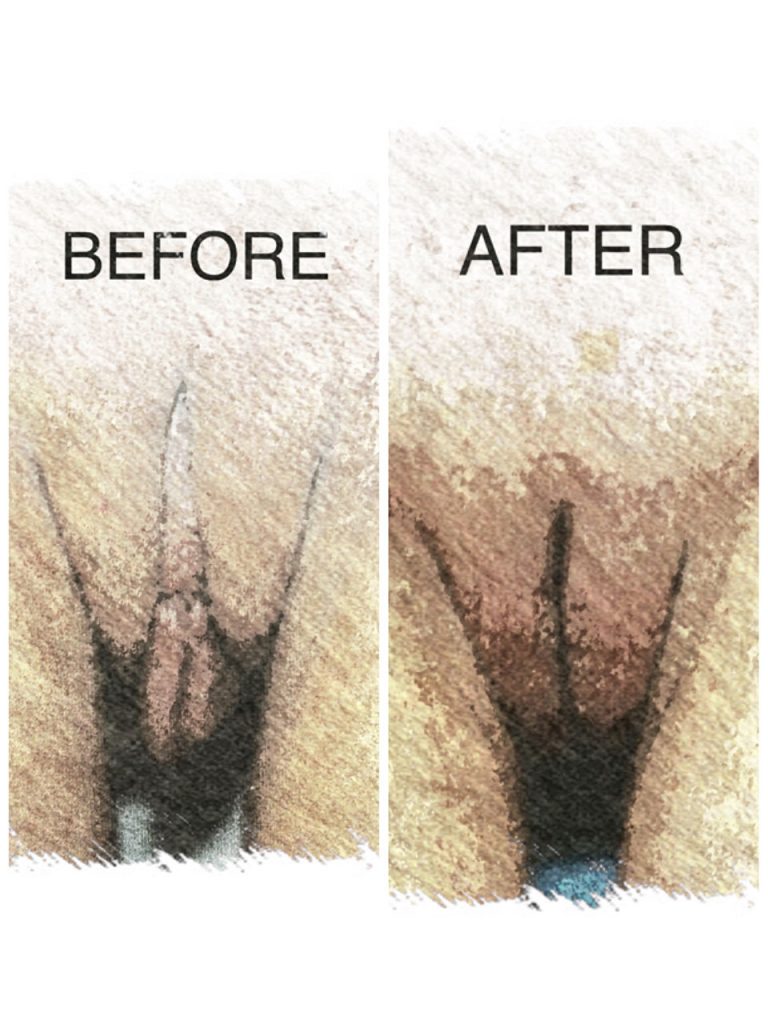Labiaplasty
Labiaplasty is a plastic surgery procedure which involves altering the labia minora (inner labia) and the labia majora(outer labia), the folds of skin surrounding the vulva.

Labiaplasty has been practiced since the 1970’s when women thought that the labia minora should not protrude beyond the labia majora for aesthetic and fuctional satisfaction.1
Because there are not many images of the vulva on social media or even textbooks, women have limited access to knowledge on vulvar anatomy. Therefore, they are unable to say what a “normal” vulva looks like. Because pornographic images are so easily available on the internet, this is likely the probable source of comparison of women of their vulvar structures and it is not uncommon for a woman, dissatisfied with her anatomy to bring a photo from a porn site to demonstrate how they would like their genitals to look like.
In 2005, a study was reported on measurements of the average size, color and texture of the various parts of the female vulva and the following table was published at the British Journal of Obstetrics & Gynecology2:
Measurements |
Mean [standard deviation] | |
| Clitoral length (mm) | 5.0 – 35.0 | 19.1 [8.7] |
| Clitoral glans width (mm) | 3.0 – 10.0 | 5.5 [1.7] |
| Clitoris to urethra (mm) | 16.0 – 45.0 | 28.5 [7.1] |
| Labia majora length (cm) | 7.0 – 12.0 | 9.3 [1.3] |
| Labia minora length (mm) | 20 – 100 | 60.6 [17.2] |
| Labia minora width (mm) | 7.0 – 50.0 | 21.8 [9.4] |
| Perineum length (mm) | 15.0 – 55.0 | 31.3 [8.5] |
| Vaginal length (cm) | 6.5 – 12.5 | 9.6 [1.5] |
| Tanner Stage (n) | IV | 4.0 |
| Tanner Stage (n) | V | 46 |
| Color of the genital area
compared to the surrounding skin (n) |
Same color | 9.0 |
| Color of the genital area
compared to the surrounding skin (n) |
Darker color | 41 |
| Rugosity of the labia (n) | Smooth (unwrinkled) | 14 |
| Rugosity of the labia (n) | Moderately wrinkled | 34 |
| Rugosity of the labia (n) | Markedly wrinkled | 2.0 |
Despite this, there is still no current established aesthetic ideal as to how the labia minor should look like. However, it is a common consensus that labia minor protruding past the labia majora are both aesthetically and functionally considered unsatisfactory. Aside from the labia minora, the labia majora has also been perused especially when porn centerfold photography started to show the female genitalia more prominently than the female breast.
Because of the huge variations in the vulvar anatomy, a patient’s expectations have to be managed and tailored towards realistic expectations because just like with plastic surgery of the face, one cannot convert an Oprah Winfrey to an Angelina Jolie.
TECHNIQUES FOR LABIAPLASTY:
Wedge resection technique
It is rare for women who want labiaplasty to want to preserve the pigmented edge of their labia. For these cases, a wedge resection is ideal because central wedge-resection involves cutting and removing a partial-thickness wedge of tissue from the thickest portion of the labium minus. Unlike the edge-resection technique, the resection pattern of the central wedge technique preserves the natural rugosity (“wrinkled” edge) of the labia minora. If performed as a full-thickness resection, there is the risk of damaging some labial nerves, which can result in painful neuromas and numbness. A partial thickness removal of mucosa and skin, leaving the submucosa intact, decreases the risk of this complication.3 Furthermore, the central wedge-resection technique can be a tricky procedure since it is sometimes difficult to estimate the correct amount of labial skin to remove, so there is always the risk of either under-correction (persistent tissue-redundancy), or the overcorrection (excessive tension to the surgical wound),which may lead to increased probability either dissatisfaction or surgical wound dehiscence. One benefit, though is that extended wedge can be brought upwards towards the prepuce to treat a prominent clitoral hood without needing to create a separate incision.4 This leads to a natural contour for the finished result, and avoids direct incisions near the highly-sensitive clitoris.

De-epithelialization/Demucosalization technique
For women with thin or atrophic labia, labial reduction by means of the de-epithelialization of the tissues is ideal. It involves cutting the epithelium of a central area on the inside and outside part of each labium minora, either with a scalpel or, low current pinpoint cautery, radiofrequency or laser knife. This method reduces the vertical excess tissue, while preserving the natural rugae (corrugated free-edge) of the labia minora. It plumps up the tissues since only the outer skin is removed plus it preserves the sensory and erectile characteristics of the labia. The disadvantage, though, of de-epithelialization is that the width of the individual labium might increase if a large area of labial tissue must be de-epithelialized to achieve the labial reduction.

Labiaplasty with Clitoral Unhooding
 Patients with large labia minora may also have a redundant or widened clitoral hood. This is where a labial reduction procedure may include the resection of the clitoral prepuce or clitoral hood when the thickness of its skin is considered unaesthetic to the patient or partner, or if it interferes with the woman’s sexual response. 5,6
Patients with large labia minora may also have a redundant or widened clitoral hood. This is where a labial reduction procedure may include the resection of the clitoral prepuce or clitoral hood when the thickness of its skin is considered unaesthetic to the patient or partner, or if it interferes with the woman’s sexual response. 5,6
Many waxing salons are sprouting in many countries, which Increases the awareness of women to wax their pubic hair. More women are choosing to use tight fitting gym outfits, swimwear and garments which can lead to more complaints of the labia minora getting caught mechanically or being abraded. It is also natural that women are getting more conscious of how their genitals appear.
Proper counseling needs to be given to women to assess the severity or deviation from normal anatomy, potential complications discussed before subjecting women to any procedure.
- Hamori CA. Aesthetic surgery of the female genitalia:labiaplasty and beyond. Plast Reconstr Surg 134:661, 2014.
- Lloyd, Jillian; Crouch, Naomi S.; Minto, Catherine L.; Liao, Lih-Mei; Creighton, Sarah M. (May 2005). “Female genital appearance: “normality” unfolds”. BJOG: An International Journal of Obstetrics & Gynaecology. Wiley. 112(5): 643–646.doi:10.1111/j.1471-0528.2004.00517.x. PMID15842291. Pdf.
- Alter, Gary J. (March 1998). “A new technique for aesthetic labia minora reduction”. Annals of Plastic Surgery. Wolters Kluwer. 40(3): 287–290.doi:10.1097/00000637-199803000-00016. PMID9523614.
- Alter, Gary J. (December 2008). “Aesthetic labia minora and clitoral hood reduction using extended central wedge resection”. Plastic and Reconstructive Surgery. Lippincott Williams & Wilkins. 122(6): 1780–1789.doi:10.1097/PRS.0b013e31818a9b25. PMID19050531.
- Hamori, Christine A. (1 September 2013). “Postoperative clitoral hood deformity after labiaplasty”. Aesthetic Surgery Journal. Oxford Journals. 33(7): 1030–1036.doi:10.1177/1090820X13502202. PMID24005612
- Hunter, John G. (1 September 2013). “Commentary on: postoperative clitoral hood deformity after labiaplasty”. Aesthetic Surgery Journal. Oxford Journals. 33(7): 1037–1038. doi:10.1177/1090820X13503476. PMID24081697.





